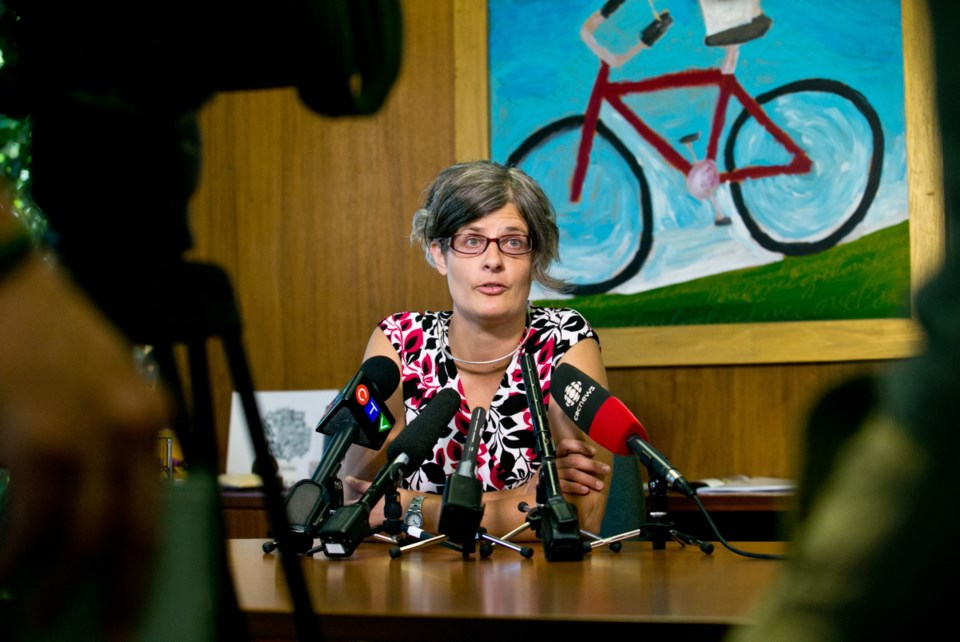The jury is out on whether a proposed micro-housing village will be met with the same public backlash that met a plan to put a temporary tent city in a Victoria park.
“It’s a good question,” said Coun. Ben Isitt, a champion of the idea of using the southwest corner of Topaz Park for a temporary designated tenting area.
While a location has not been determined for the micro-housing village — a collection of shed-sized houses for 35 to 50 homeless people — it will not be in a park, Isitt said.
“It sounds like we’re looking for privately owned commercial land … between downtown and the Saanich border,” he said. “So certainly, discussions with Burnside-Gorge residents are going to be necessary.”
Mayor Lisa Helps pushed the pause button Tuesday on plans to erect a temporary tent city in a park after residents campaigned against it.
Staff had eyed Topaz Park, the city’s second largest after Beacon Hill, as the most likely site and had been working to find a service provider to run it. Helps said no further steps will be taken until residents are consulted, likely through city-sponsored workshops.
The mayor, who has publicly apologized for the botched roll-out of the homeless tenting plan, said the city has learned from the experience and will ensure neighbours are fully involved in any decision to erect a micro-housing community. The tiny houses are part of the city’s plan to help homeless people.
“Do I anticipate push back? It depends, quite frankly, on how the micro-housing community looks,” Helps said.
“They’ve got a lot of architects involved and I think it could look quite spectacular and be something that isn’t akin at all to a temporary tenting area.”
Coun. Geoff Young said he expects the project to face backlash because it raises issues similar to those surrounding the tent city. But it’s difficult to predict how people will react, he added, because it’s yet to be determined how the houses will be serviced.
Victoria has been trying to find a solution to people tenting in city parks since a 2008 Supreme Court decision ruled that, in the absence of available shelter beds, it’s unconstitutional to deny a person the right to erect shelter in a city park.
City staff estimate that about 130 people sleep in parks on any given night. Associated costs, such as having police and bylaw officers move campers along every morning, garbage cleanup and environmental damage, are $600,000 a year.
Helps said the situation is one the city can’t ignore.
“Part of the reason this has come to this discussion is we’ve received hundreds, hundreds of emails from people living near parks, from business people with businesses near parks, saying, ‘Please council, you’ve got to do something,’ ” she said.
Designated tenting areas are not the best solution, Helps said, adding she hopes a better solution can be found through consultation with residents.
“Maybe we find a better site. Maybe we find a city facility that is indoors that is not a park,” she said.
“Right outside my window is the Centennial Square parkade. There’s 24-hour security. There’s 24-hour washrooms. It might be something we could look at, again, as a temporary measure.”
Isitt and Helps are planning a walkabout of Topaz Park this evening to address issues around tenting in the park.
Isitt said he still believes a designated tenting site in the park could work.
Residents living next to small neighbourhood parks are bearing a disproportionate share of the problems associated with people sheltering in parks, Isitt said.
“These tiny parks sometimes have 12 or more tents in a night. There’s no washroom facilities. There’s quite a bit of impact on natural areas and these are families living with shared fencelines, immediately adjacent to someone sleeping in a park,” Isitt said.
“So when I look at the city’s second-largest park, which is Topaz, I think there’s got to be a way to manage overnight sheltering in a way that would have substantially less impact than what our residents are currently dealing with.”



